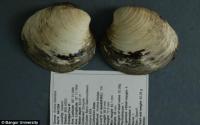 In February of last year, we posted about posidonia oceanica, known as Neptune grass, a variety of sea grass that covers the ocean floor from Spain to Cyprus. Some plants hare believed to be around 200,000 years old, making them the oldest living life form on the planet. The plant reproduces by cloning so the DNA of any given plant be very, very old. But what is the oldest non-colonial animal? Scientists gathered a mollusk from the Icelandic shelf in 2006 as part of a study of climate change. Mollusks are generally thought to live for around 100 years. One of the mollusks collected was much older.
In February of last year, we posted about posidonia oceanica, known as Neptune grass, a variety of sea grass that covers the ocean floor from Spain to Cyprus. Some plants hare believed to be around 200,000 years old, making them the oldest living life form on the planet. The plant reproduces by cloning so the DNA of any given plant be very, very old. But what is the oldest non-colonial animal? Scientists gathered a mollusk from the Icelandic shelf in 2006 as part of a study of climate change. Mollusks are generally thought to live for around 100 years. One of the mollusks collected was much older.
An arctica islandica bivalve mollusk, also known as an ocean quahogs, was found that was initially thought to be over 400 years old. It was nicknamed Ming the Mollusk, as it apparently lived during the Chinese dynasty, though with in a different neighborhood. More recent analysis, however, suggests that the mollusk was in fact more than 100 years older — dating back 507 years.
There has been a minor uproar on the internet over how this date was determined. To count the layers of shell by which scientists can calculate the age of the mollusk, it is necessary to open the shell, thereby killing the mollusk. The scientists at Bangor University point out that the mollusk was dredged from the bottom in 2006 and died when it was put in a freezer with all the other samples collected, well before they pried it open to count the shell layers.

Yes, its all over the web that they killed it.
But is that 507 clam years, or 507 human years?
Has the MV Palanpur carrying the hull of 1864 Clipper ship “City of Adelaide” arrived at Norfolk, Virginia yet?